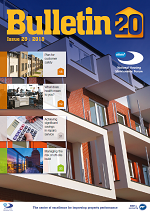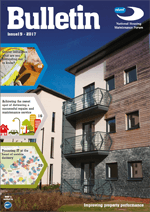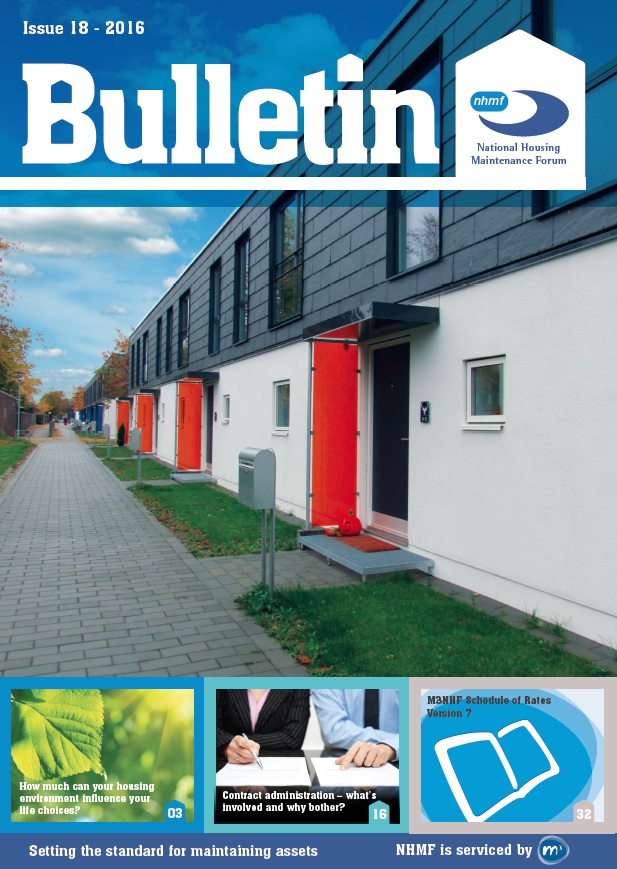NHMF best practice
These two new best practice sections will help social landlords to maintain quality homes in an increasingly challenging economic environment. The Compliance Section has a set of topical guides summarising social landlords’ responsibilities for meeting essential statutory health and safety requirements and explain how to do this economically and efficiently. The Fuel Saving Section explains how to include a fuel saving strategy as a key aspect of an organisation’s business plan. The Guide then sets out how to develop a practical improvement strategy as an integral part of the asset management programme and how to successfully deliver the improvements and manage the risks. There are also best practice training courses which relate to this guide.
Fire safety
Scope
This guide covers social landlords’ responsibilities for fire safety in residential premises, including individual homes, purpose-built blocks of flats and sheltered housing. It does not cover property protection or insurance requirements in the case of fire.
High rise towers and fire safety – urgent action for Registered Providers
Anthony Collins Solicitors have prepared the following briefing note to help address the immediate and medium-term issues for fire safety, whether or not tower blocks are subject to DCLG testing.
Government ban on combustible materials in the external walls of certain buildings over 18m in height – Q&A briefing
-
Which buildings does this ban apply to?
The restrictions apply to the external walls for residential blocks of flats, student accommodation, care homes, sheltered housing, hospitals and dormitories in boarding schools with a storey above 18 m in height.
It also applies to ‘specified attachments’ to such buildings, such as balconies and solar panels.
-
What materials does this ban apply to?
The amendments require that all materials which become part of an external wall or specified attachment achieve European Class A2-s1, d0 or Class A1.
‘External wall’ includes anything located within any space forming part of the wall, including any windows and doors in the wall (but their components are exempt) and any part of a roof pitched at an angle of more than 70 degrees to the horizontal if that part of the roof adjoins a space within the building to which persons have access (but not access only for repairs or maintenance). There is a list of exempt components in the amendments to Part B of the Building Regulations.
-
Does this ban apply to existing cladding of multi-storey flats?
No. This ban applies only to new buildings. However, it would be good practice to refer to these new requirements when planning any new cladding or replacement of existing cladding to multi-storey blocks of flats.
-
When does this ban come into force?
The Amendment Regulations came into force on 21 December 2018.
-
What is the situation for projects about to start or that have started on site?
The Amendment Regulations will not apply where an initial notice has been given to, or full plans deposited with, a local authority before 21 December 2018 and either the building work to which it relates has started before that day or is started within two months.
-
What should be done about existing cladding of multi-storey flats?
Landlords should be following Government advice after the fire at Grenfell Tower (see below). In particular, they should have completed testing of any existing cladding required by the Government’s Building Safety Programme.
On multi-storey blocks of flats for which testing was not required, it would be good practice for landlords to check the nature and specification of the materials were in the external walls.
-
What should be done when removing or replacing existing cladding of multi-storey flats?
If the building has a storey above 18m in height, identify any materials that do not comply with the new requirements and assess if these can be removed and replaced when the work is done.
-
What should be done when planning to over-clad existing multi-storey flats?
If the building to be over-clad has a storey above 18m in height, ensure that the materials specified comply with the new requirements.
-
Where can I find more information?
A. The Government has published these documents explaining these new requirements:
- 2018 amendment to Approved Document B (fire safety) volume 2: buildings other than dwellinghouses
- 2018 amendment to Approved Document 7: material and workmanship
- Building (Amendment) Regulations 2018: Circular 02/2018
B. NHBC has also published guidance.
-
How can I keep up to date?
By subscribing to updates from Building Control Bodies, such as LABC and NHBC and to MCHLG news releases.
-
What good practice is available to social landlords for fire safety in multi-storey blocks of flats?
The NHMF Best Practice website provides best practice case studies
-
What should landlords be doing after the fire at Grenfell Tower?
Landlords should:
- Sign up to the weekly updates from the Government’s 'Building Safety Programme' so that they can keep up to date with the investigations into the Grenfell Tower fire.
- Check that they are complying with all the current fire safety legislation, in particular ensuring that their fire risk assessments are up to date and they are acting on those assessments. The NHMF Best Practice website provides links to the legislation and sources of approved guidance, such as ‘Fire safety in purpose-built flats’.
- Study the interim guidance the Government has published.
-
What plans does the Government have to implement the recommendations in the Hackitt Review?
The Government has announced that it will implement the recommendations in the Hackitt Review and has published its implementation plan.
-
What are the implications for social landlords?
The Government expects all building owners, including social landlords, to take responsibility for ensuring that residents are safe. Social landlords should expect greater scrutiny as to how they ensure their residents are safe.
It will be introducing a tougher regulatory framework. Its implementation plan sets out how the elements of that new framework will be developed over the coming months, leading to legislative changes at the earliest opportunity.
The Government intends to trial a new regulatory framework through a Joint Regulators Group (drawing together the expertise of the HSE, Local Authority Building Control (LABC) , the Fire and Rescue Services through the National Fire Chiefs’ Council (NFCC) and the Local Government Association)), to test and develop new approaches that will become enshrined in the new legislation for better building safety.
The implementation plan sets out the programme of work to ensure that residents are safe, and feel safe, in their homes. It will:- create a stronger and more effective regulatory and accountability framework for buildings in scope, which will have responsibility and accountability for keeping people safe at its core
- prevent people from flouting the system through tougher oversight and a stronger and more effective sanctions and enforcement regime
- facilitate better understanding of what is required to ensure buildings are safe through clearer standards and guidance, as well as improving the rigour of the product labelling, testing and marketing process to ensure that people working on buildings use safe products
- ensure that residents are put at the heart of the new regulatory framework through better engagement between them and those managing their buildings, as well as providing more effective routes for escalation and redress when things go wrong. Building owners will be required to reassure residents by providing them with better information about the protection measures in place in their buildings.
- drive culture change by working with industry to increase responsibility for building safety, including by improving the competence of those undertaking building work.
-
What should landlords do who have a Primary Authority partnership for fire safety?
Landlords need to check with their Primary Authority partnership:
- That their partnership has been transitioned.
- What their fire safety partnership covers.
-
What is a Primary Authority partnership?
The NHMF has published a case study on a Primary Authority fire safety partnership.
Landlords are responsible for ensuring fire safety, with the main duty being to carry out and act on fire risk assessments.
The Housing Act 2004 covers England and Wales and applies to individual homes, including the licensing of houses in multiple-occupation (HMO) and other residential accommodation. The Act introduced the Housing Health and Safety Rating System (HHSRS) for use in England and Wales. The Regulatory Reform (Fire Safety) Order 2005 (the FSO) applies to common parts of blocks of flats.
In England and Wales, fire risks to individual homes are assessed through the HHSRS. Both the Housing Act and the FSO apply to purpose-built blocks of flats, with the FSO bringing common parts of blocks of flats within the scope of mainstream fire safety legislation for the first time. The FSO requires fire risk assessments to be carried out and acted upon rather than meeting a set of prescribed measures. In addition to the FSO, other guidance such as the Government’s Fire safety risk assessment: sleeping accommodation can be useful. All new housing, including conversions and "material alterations" needs to comply with the fire safety requirements of the Building Regulations (Part B). Building Regulations do not apply retrospectively to existing properties but any major refurbishment and improvement work should not make the level of fire performance worse. While not mandatory, such major refurbishment and improvement work, when considered alongside the most recent Fire Risk Assessment, is an opportunity to consider the practicalities and economics of improving the fire performance of building.
In Scotland, guidance is provided in relation to sleeping accommodation under Part 3 of the Fire (Scotland) Act 2005, as amended. The Act applies to most non-domestic premises (premises which are not private dwellings) and to HMOs which require a licence. It requires those persons with responsibility for premises to ensure the safety of others by putting in place appropriate fire safety measures based on an assessment of risk.
In Northern Ireland, HMOs and flats and maisonettes are covered by the Housing (Northern Ireland) Order 1992 but the Fire Safety Regulations (Northern Ireland) 2010 apply to other residential sleeping accommodation, such as hostels.
The HHSRS under the Housing Act is enforced by local authorities, for category 1 hazards an improvement notice will be served or, in more extreme cases, a prohibition order may be served. The Act gives local authorities powers of access for the purposes of inspecting to see if a category 1 or 2 hazard exists. The FSO is enforced by the local fire and rescue authority. Building Regulations are enforced by the Building Control Body (either local authority building control or a private-sector approved Inspector).
Social landlords also have to comply with specific legal requirements for housing and those relating to maintaining safe and healthy homes set out in each country’s regulatory framework (see Housing Regulators below). The relevant housing legislation for each country is set out below.
In England and Wales the Housing Act 2004 applies to individual homes, including the licensing of houses in multiple-occupation (HMO) and other residential accommodation. Risks are assessed through the Housing Health and Safety Rating System (HHSRS).
The relevant legislation in Scotland is the Housing (Scotland) Act 2014 and for Northern Ireland main legislation is the Housing (Northern Ireland) Order 1981, with all relevant legislation listed by the Department for Social Development.
In England, the Regulator of Social Housing (RSH), requires registered providers to comply with its Regulatory Standards. On 1 October 2018 the RSH became a standalone public body, independent from the Homes and Communities Agency (HCA). On 11 January 2018, the HCA’s non-regulation arm adopted its new trading name Homes England. Managing fire safety is covered by the Home Standard that requires meeting all statutory requirements for the health and safety of occupants.
In Wales, all social landlords are required to meet and maintain the Welsh Housing Quality Standard (WHQS) as soon as possible, with 2020 the absolute deadline. In relation to fire safety, landlords are to ensure easy escape routes and provide sufficient fire and smoke alarms.
In Scotland, social landlords are required to meet the minimum Scottish Housing Quality Standard (SHQS). Meeting the SQHS includes compliance with Technical Guide for healthy, safe and secure homes. For fire safety landlords should provide at least one smoke detector in each property and maintain them. The Scottish Housing Regulator expects compliance with all statutory and regulatory obligations including fire safety.
In Northern Ireland the Department for Social Development regulates registered housing associations under the Regulatory Framework for Registered Housing Associations in Northern Ireland 2006. Regulatory Standard 3.3 states that housing associations must develop manage and maintain good-quality homes that seek to meet people’s needs and preferences now and in the future. This includes meeting the Decent Homes Standard and compliance with all statutory and regulatory obligations including fire safety.
Comprehensive guidance is available on Fire safety in purpose-built flats. While this deals specifically with purpose-built flats, it also provides advice on all legislation and guidance relating to residential fire safety. In particular the guidance explains how to commission, carry out and act on fire risk assessments. To ensure that recommended work from fire risk assessments is carried out, one landlord requires assessors to produce a schedule of works for each scheme assessed so that the identified remedial works can be collated and used in any procurement exercise. Guidance is also provided on fire and smoke alarms, emergency lighting, wet and dry risers, fire fighting equipment and extinguishers, sprinklers and sprinkler systems, smoke vents, fire doors, building compartmentation and bin chute fire dampers. The London Fire Brigade has published advice "Know the Plan" for those living in blocks of flats and for landlords.
Some landlords carry out weekly inspections of common areas to check that fire protection systems, including fire doors, are in good working order. Landlords have a management responsibility to ensure that residents do not compromise fire safety by, for example, replacing flat entrance self-closing fire doors with non-compliant ones. Landlords are responsible for providing advice to residents about fire escape routes and what they should do in the event of a fire. Based on a landlord’s fire risk assessments, policies may be needed in relation to the management of common parts and means of escape in blocks of flats i.e. to what extent they should be kept clear.
For landlords with stock in more than one local authority that would normally involve dealing with each local enforcing authority, the government set up the Primary Authority scheme scheme to provide regulatory certainty and consistency. Fire safety has been included in the scheme, which applies to England and Wales. Some landlords have established a Primary Authority agreement with a fire and rescue authority, particularly in relation to older and vulnerable people’s housing for which fire safety is more complicated. Community Housing Cymru has been developing a coordinated partnership for welsh housing associations.
Guidance on fire safety provisions for certain types of existing housing is available for landlords and fire safety enforcement officers in both local housing authorities and in fire and rescue authorities on how to ensure adequate fire safety in certain types of residential accommodation. This guidance covers a range of residential accommodation and includes case studies for single dwellings, shared houses, bedsits, flats and flats which are multi-occupied. However, many of the issues are addressed in the "Purpose-built flats" guidance.




